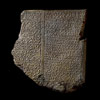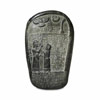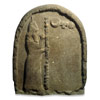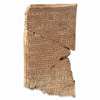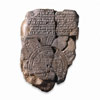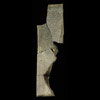
Translation of artifacts provided courtesy
of:
The British Museum 2003
MORE ARTICLES: VIDEO - THE FLOOD TABLET (real player format) Sumerian Culture and the Anunnaki |
Map of the World
Babylonian, about 700-500 BC
Probably from Sippar, southern Iraq
A unique ancient map of the Mesopotamian world
This tablet contains both a cuneiform inscription and a unique map of the Mesopotamian world. Babylon is shown in the centre (the rectangle in the top half of the circle), and Assyria, Elam and other places are also named. The central area is ringed by a circular waterway labelled 'Salt-Sea'. The outer rim of the sea is surrounded by what were probably originally eight regions, each indicated by a triangle, labelled 'Region' or 'Island', and marked with the distance in between. The cuneiform text describes these regions, and it seems that strange and mythical beasts as well as great heroes lived there, although the text is far from complete.
The regions are shown as triangles since that was how it was visualized that they first would look when approached by water.
The map is sometimes taken as a serious example of ancient geography, but although the places are shown in their approximately correct positions, the real purpose of the map is to explain the Babylonian view of the mythological world.
Height: 12.2 cm
Width: 8.2 cm
I.L. Finkel, 'A join to the Map of the World: a notable discovery', British Museum Magazine: the Journal of the British Museum Friends (Winter 1995), pp. 26-27
I.L. Finkel, Gilgamesh: the hero king (London, The British Museum Press, 1998), p. 38
W. Horowitz, Mesopotamian cosmic geography (Winona Lake, Eisenbrauns, 1998)
